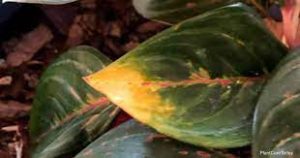Chinese evergreen plants are prized for their stunning green foliage and their ability to thrive in indoor environments. But it can be disheartening to see the leaves of these beautiful plants turn yellow.
Yellowing leaves are often a sign of underlying issues that need to be addressed promptly to restore the plant’s health and vitality. Let’s explore the most common causes of Chinese evergreen leaves turning yellow.

9 Causes of Chinese Evergreen Leaves Turning Yellow
Overwatering
Overwatering is one of the primary culprits behind yellowing leaves in Chinese evergreen plants. When the roots are constantly soaked in water, they suffocate and develop root rot.
Root rot hinders the plant’s ability to absorb nutrients. Yellowing of leaves is the leading sign of nutritional deficiency. Allow the soil to dry out between waterings.
Another option is to stick your finger about an inch into the soil to if it feels dry and time to water. Ensure there is proper drainage by using pots with drainage holes or adding a layer of gravel at the bottom.
Underwatering
While overwatering can cause yellowing, underwatering can have the same effect. Insufficient water supply deprives the plant of essential nutrients, leading to leaf dehydration and discoloration.
Establish a consistent watering routine, ensuring the soil remains evenly moist but not waterlogged. Adjust the frequency based on the plant’s specific needs and environmental conditions.
Not Enough Sunlight
Chinese evergreen plants thrive in moderate to bright indirect sunlight. Insufficient exposure to light can result in chlorophyll breakdown, leading to yellowing leaves.
Place your plant near a window where it can receive bright, filtered light. But avoid direct sunlight as it can scorch the leaves. If natural light is limited, consider using artificial grow lights specifically designed for plants.
Extreme Temperature
Chinese evergreen plants prefer a stable temperature range between 65-85°F (18-29°C). Exposure to extreme temperatures, such as cold drafts or excessive heat, can stress the plant and cause leaf yellowing.
Keep your plant away from drafty windows, doors, or air conditioning vents. Avoid placing it near heating sources. Maintaining a consistent and moderate temperature will promote healthy leaf growth.
Transplant Stress
Transplanting Chinese evergreen plants can lead to leaf yellowing due to the stress it imposes on the plant. During transplantation, the roots may be disturbed, affecting nutrient uptake and causing discoloration.
Choose a slightly larger pot with good drainage and use a well-draining potting mix. Be gentle when handling the plant to minimize stress, and ensure proper watering and care during the recovery period.
Pest Infestation
Pests such as spider mites, mealybugs, and scale insects can infest Chinese evergreen plants, causing damage to the leaves. These pests feed on the plant’s sap, weakening the foliage and causing yellowing.
Regularly inspect your plants for signs of pests, such as webbing, sticky residue, or visible insects. If an infestation is detected, treat it with appropriate insecticidal soap or horticultural oil.
Disease Problems
Fungal or bacterial diseases, including root rot and leaf spot, can contribute to yellowing leaves in Chinese evergreen plants. These diseases thrive in excessively moist environments or poor air circulation.
Avoid overwatering and provide adequate ventilation around the plant. If signs of disease appear, promptly remove affected leaves, improve air circulation, and consider applying a suitable fungicide as directed.
Fertilizer Application
Improper fertilizer application can result in nutrient imbalances, leading to yellowing leaves. Overfertilization can cause nutrient toxicity, while underfertilization can cause deficiencies.
Follow a balanced fertilization schedule and use a slow-release, balanced fertilizer specifically formulated for houseplants. Dilute the fertilizer to avoid overfeeding and flush the soil with water to prevent salt buildup.
Natural Aging Process
Yellowing leaves can be a natural part of the aging process for Chinese evergreen plants. As leaves reach the end of their lifespan, they naturally turn yellow and eventually drop off.
Regularly remove dead or dying leaves to maintain the overall appearance of the plant. If a significant number of leaves are yellowing prematurely, it indicates an underlying issue that needs to be addressed.
Final Thoughts From Experts
Understanding the causes of yellowing leaves in Chinese evergreen plants is essential for their proper care and maintenance. By addressing the above factors, you can get assured that your plants remain healthy and vibrant.
Regular observation, proper watering practices, adequate light exposure, suitable temperatures, and timely pest and disease management are key to preserving the beauty of your Chinese evergreen plants.
Remember, prevention is always better than cure, so provide optimal conditions for your plants and address any issues promptly to enjoy their lush green foliage for years to come.
People Who Read This Also Read:






